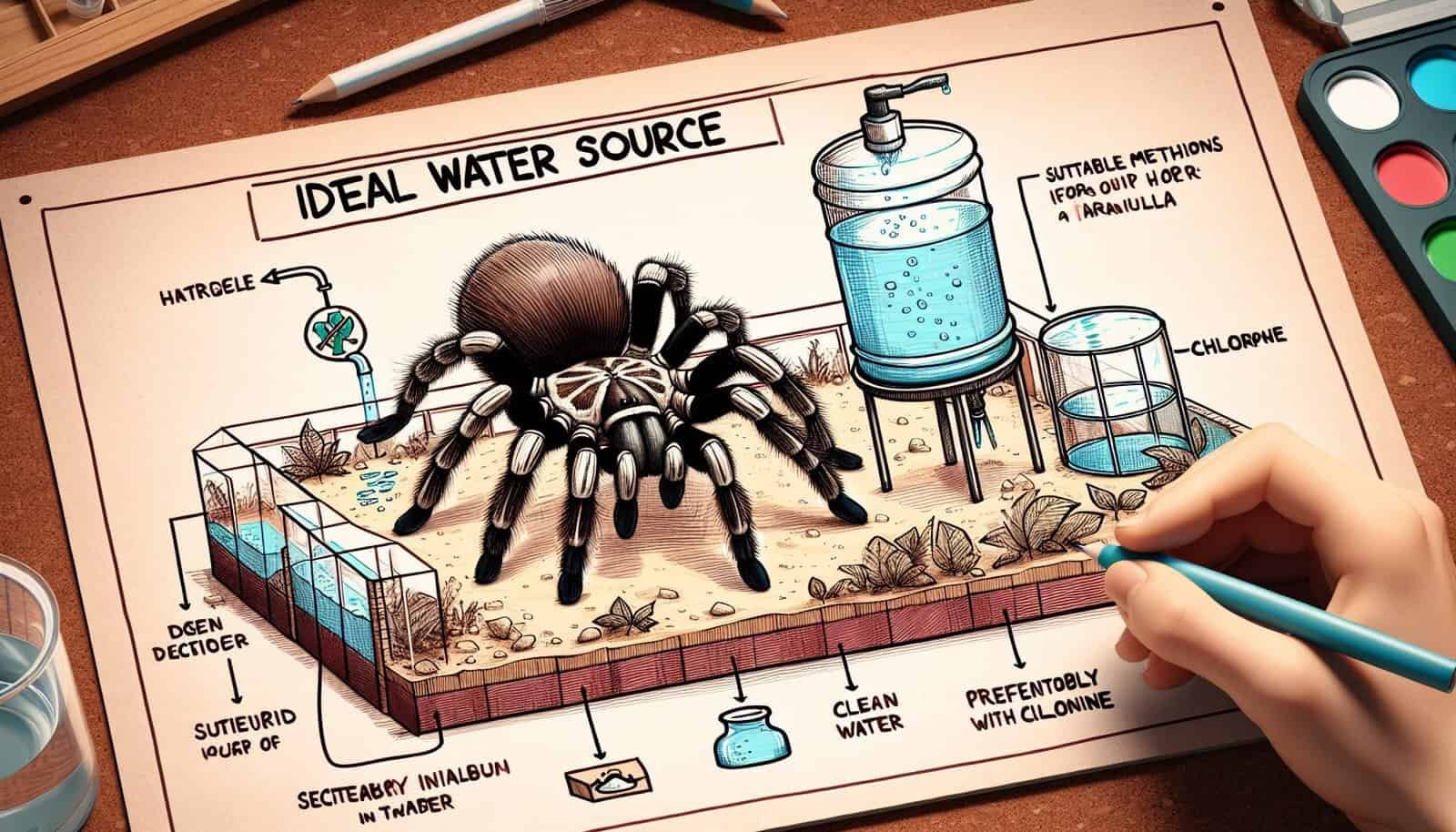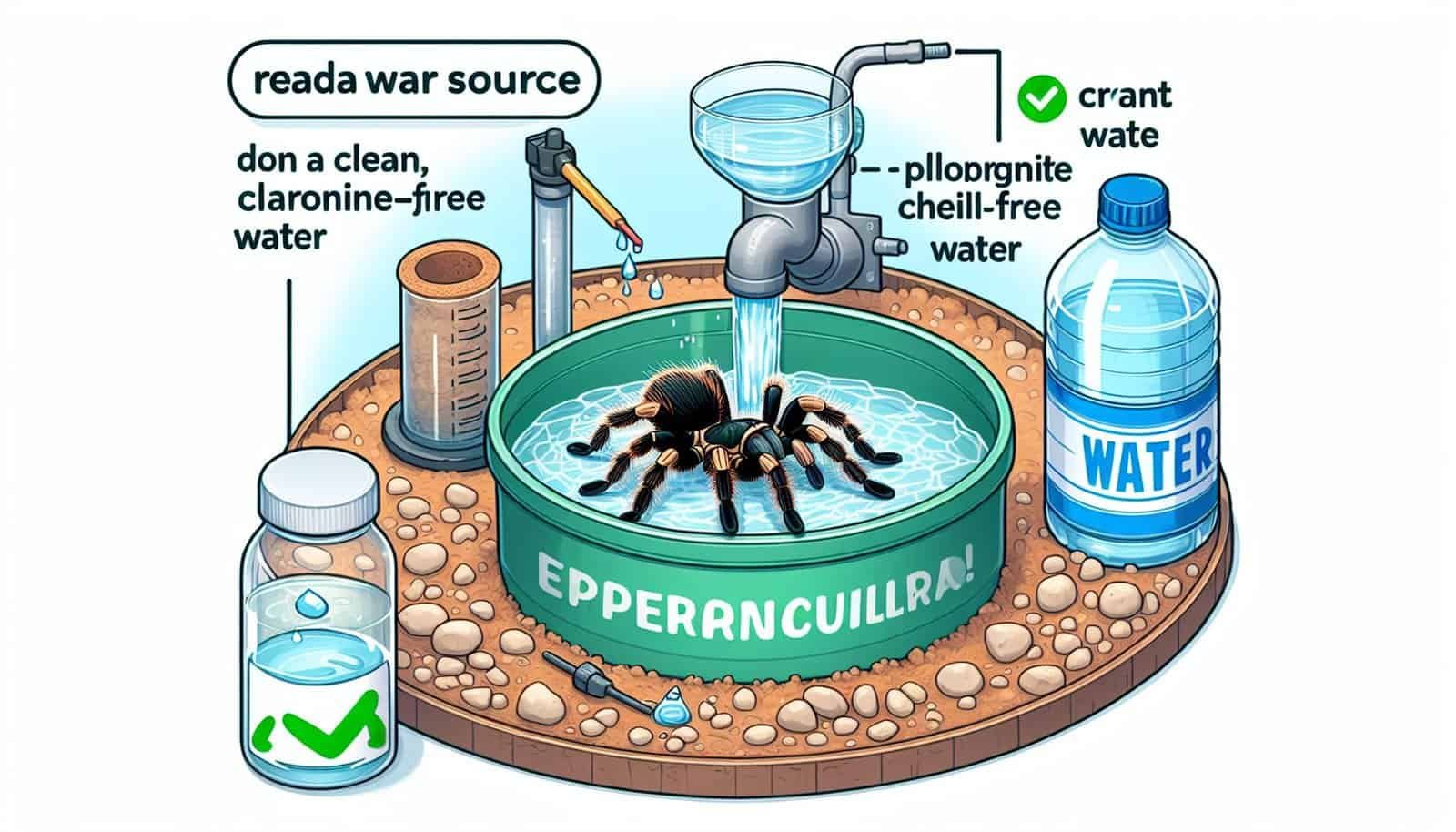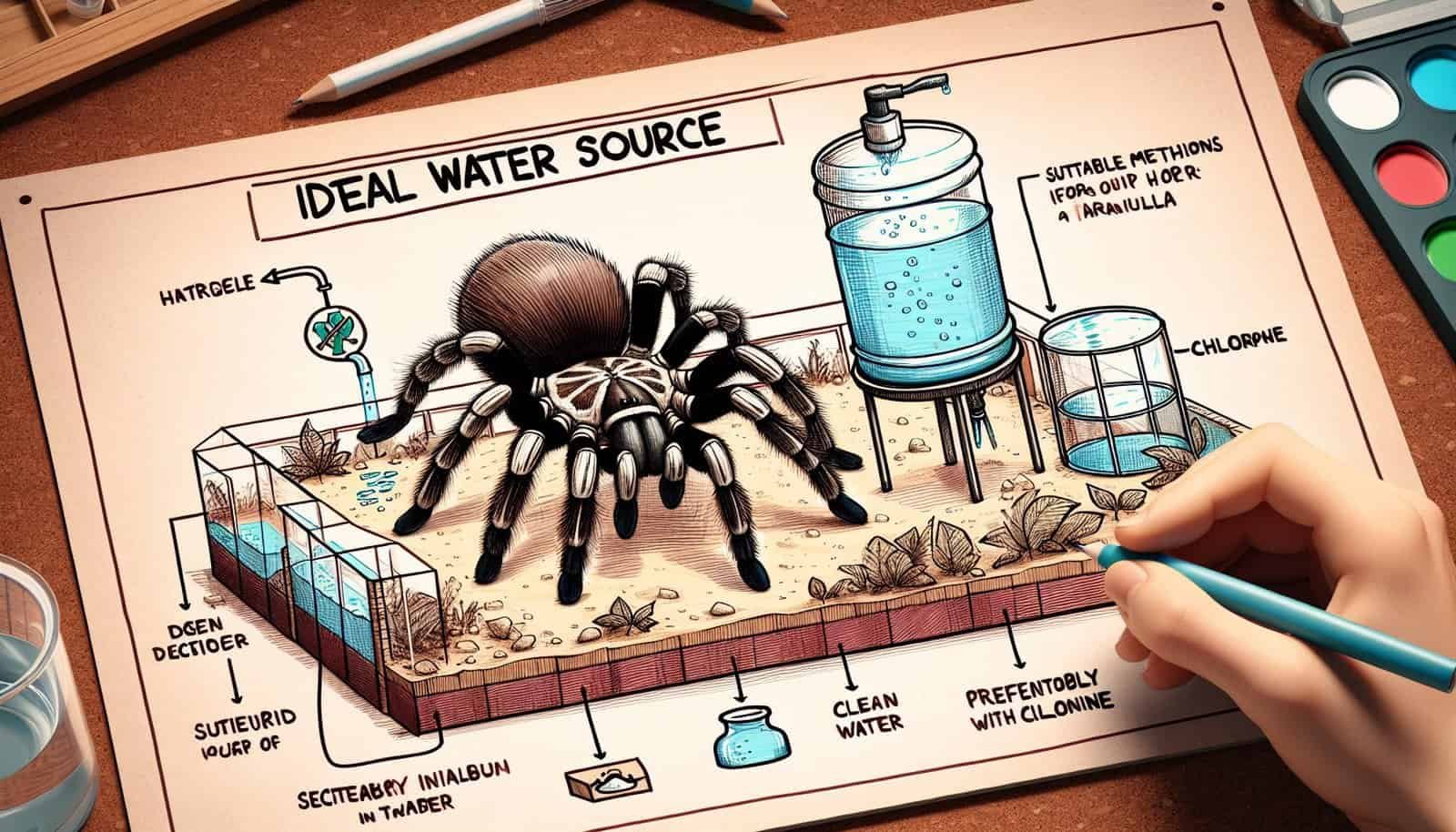So, you’ve taken the plunge and decided to become a proud owner of a tarantula. Congratulations on your unique choice of pet! Now, one of the essential aspects of caring for your eight-legged friend is ensuring they have a proper water source. But how exactly do you go about providing the perfect hydration for your tarantula? In this article, we will explore some simple yet effective methods to keep your little arachnid happy, healthy, and hydrated.

Choosing the Right Water Source
Understanding Tarantula Water Needs
When it comes to providing a proper water source for your tarantula, it is crucial to understand their water needs. Tarantulas are not like typical pets that require large amounts of water to drink. In the wild, tarantulas obtain most of their hydration from the prey they consume. Water plays a more significant role in maintaining the humidity levels within their enclosure rather than being a primary source of hydration.
Types of Water Sources
There are various water sources you can choose from to ensure your tarantula’s well-being. The two most common options are filtered water and tap water. Both have their advantages and disadvantages, so it is essential to consider various factors before deciding which one to use.
Filtered Water vs. Tap Water
Filtered water, such as distilled or reverse osmosis water, is often considered the safer option for tarantulas. It removes impurities and potentially harmful substances that may be present in tap water, ensuring a cleaner source of hydration. However, it is important to note that some filtered water may lack essential minerals that tarantulas may need.
On the other hand, tap water is easily accessible and cost-effective. Most tap water quality meets the standards set for human consumption, but it can contain chlorine, chloramines, and other chemicals that may be harmful to tarantulas. If you choose to use tap water, it is recommended to use a water conditioner specifically formulated for use with reptiles or invertebrates to remove these chemicals.
Water Dish Selection
The Right Size and Shape
Choosing the right water dish for your tarantula is crucial to ensure their comfort and safety. The dish should be shallow, allowing your tarantula to drink without the risk of drowning. A good rule of thumb is to select a dish that is approximately the same size as the tarantula’s leg span to ensure easy access.
Non-Toxic Materials
It is important to select a water dish made of non-toxic materials. Avoid dishes made of plastic or other materials that may leach harmful chemicals into the water. Ceramic or glass dishes are popular choices as they are non-porous and easy to clean.
Easy Accessibility for the Tarantula
Tarantulas are notorious for being clumsy drinkers. Ensuring easy access to the water dish is essential to prevent accidents. Placing the dish in an area of the enclosure where your tarantula can easily reach it without obstacles or walls will encourage regular hydration.
Filling and Maintaining the Water Dish
Frequency of Water Refills
Monitoring the water levels in the dish is important to ensure your tarantula has access to fresh water at all times. Depending on the evaporation rate and your tarantula’s water consumption, you may need to refill the dish every few days or once a week. It is crucial to establish a routine and keep an eye on the water levels to prevent dehydration.
Avoiding Contamination
To maintain a clean water source for your tarantula, it is important to avoid contamination. Make sure to wash your hands thoroughly before handling the water dish or any tools used to refill it. This will prevent the transfer of unwanted chemicals or bacteria to the water.
Cleaning the Water Dish
Regular cleaning of the water dish is necessary to prevent the buildup of algae or bacteria. Depending on the level of contamination, you may need to clean the dish every week or every other week. Use a mild, reptile-specific disinfectant or a mixture of water and vinegar to ensure thorough cleaning. Rinse the dish well before refilling it to remove any remnants of cleaning solutions.
Safe and Hygienic Water Handling
Washing Hands Before and After
Before and after handling the water dish or interacting with your tarantula, make sure to wash your hands thoroughly. This will help reduce the risk of introducing harmful substances or bacteria to the water source or the tarantula’s enclosure.
Using Separate Tools or Containers
To further minimize the risk of contamination, it is recommended to use separate tools or containers solely for handling water-related tasks. This prevents the transfer of chemicals or bacteria from other sources to the water dish or the tarantula’s enclosure.
Avoiding Chemicals and Soaps
When cleaning the water dish or any tools used for handling water, it is important to avoid using harsh chemicals or soaps. These substances can be harmful to your tarantula if not completely rinsed off. Stick to reptile-specific cleaning products or mild solutions such as water and vinegar.

Ensuring Proper Humidity
Understanding Tarantula Humidity Needs
Maintaining the proper level of humidity in your tarantula’s enclosure is crucial for their overall health and well-being. While tarantulas do not require high humidity levels like some other reptiles or amphibians, they do need a certain level of moisture to support their respiratory functions and promote proper molting.
Water Dish Placement and Evaporation
Strategically placing the water dish in the enclosure can contribute to the overall humidity levels. Placing it near a heat source or in an area with good airflow can help promote evaporation, which in turn increases the humidity. Keep in mind that the dish should not be placed directly under or in contact with the heat source to prevent the water from getting too warm and potentially harmful.
Misting the Enclosure
In addition to the water dish, misting the enclosure can help maintain proper humidity levels. Use a fine mist spray bottle to lightly spray the walls and substrate, taking care not to dampen the area around the water dish excessively. Misting should be done sparingly to avoid creating overly damp conditions that could lead to mold growth or respiratory issues for your tarantula.
Monitoring Water Consumption
Observing Tarantula Behavior
Monitoring your tarantula’s behavior is a crucial part of ensuring they are properly hydrated. Tarantulas will often display signs of dehydration, such as lethargy or refusal to eat, if they are not getting enough water. Pay attention to any changes in their activity levels or feeding habits, as these could indicate a need for increased water availability.
Using Water Depth Indicators
Water depth indicators can be helpful in determining how much water your tarantula drinks over time. These indicators are small strips or stickers that change color when they come into contact with water. By placing them in the water dish, you can easily monitor the water consumption and refill the dish as needed.
Keeping Records
Keeping a record of your tarantula’s water consumption can provide valuable insights into their hydration needs. Note the frequency and amount of water refills, as well as any changes in your tarantula’s behavior or appearance. This record can help you identify patterns and make adjustments to ensure your tarantula is receiving adequate hydration.

Alternatives to Water Dishes
Using Moist Substrate
In some cases, tarantulas may prefer to obtain their hydration through the substrate in their enclosure rather than a water dish. Using a moist substrate, such as coco fiber or sphagnum moss, can provide a source of moisture for your tarantula to drink from or absorb. Be mindful of maintaining the proper moisture level to prevent overly damp conditions and mold growth.
Plant-Based Water Sources
Another alternative to a traditional water dish is providing your tarantula with plant-based water sources. You can introduce live plants that retain water, such as bromeliads or pothos, into the enclosure. The moisture from the plants’ leaves can provide an additional source of hydration for your tarantula.
Dripping Water Systems
For more advanced setups, you can consider implementing a dripping water system in your tarantula’s enclosure. This system uses a small pump or container to drip water into the enclosure, creating a continuous source of hydration. This option requires careful monitoring to avoid excessive wetness or flooding within the enclosure.
Avoiding Drowning Risks
Shallow Water Levels
To prevent the risk of drowning, it is essential to maintain shallow water levels in the dish. The water should be no deeper than the tarantula’s leg span, allowing them to reach the water easily without the risk of submersion.
Providing Escape Routes
In the event that your tarantula does accidentally fall into the water dish, it is crucial to provide them with an escape route. This can be done by placing a small piece of cork bark or a flat stone in the dish that allows the tarantula to climb out easily and avoid drowning.
Being Alert and Vigilant
As a tarantula owner, it is important to remain attentive and vigilant when it comes to their water source. Regularly check the water dish and observe your tarantula’s behavior to ensure they are not at risk of drowning or experiencing any other water-related issues. Being proactive can help prevent potential accidents and promote a safe environment for your pet.

Addressing Water-Related Issues
Dealing with Mold Growth
Mold growth in the water dish or the enclosure can be a common issue, especially in humid environments. It is crucial to address this issue promptly to prevent any harm to your tarantula. Cleaning and disinfecting the water dish regularly, reducing excess moisture in the enclosure, and ensuring good ventilation can help prevent mold growth.
Preventing Bacterial Infections
Bacterial infections can occur if the water source or the tarantula’s enclosure is not kept clean. Regular maintenance and cleaning of the water dish, as well as removing any uneaten prey items promptly, can help prevent bacterial infections. If you notice any signs of infection, such as redness, swelling, or discharge, it is recommended to consult a veterinarian who specializes in exotic pets.
Resolving Water Refusal
In some cases, tarantulas may refuse to drink from the water dish provided. This can be due to a variety of factors, including stress, territorial behavior, or individual preferences. If your tarantula consistently refuses to drink from the dish, you can try alternative methods of providing hydration, such as moistening their prey or using other water sources like moist substrate or plant leaves.
Consulting an Expert
Tarantula-Specific Information
If you have specific questions or concerns about providing a proper water source for your tarantula, seeking advice from experts is highly recommended. Reputable tarantula breeders, hobbyist groups, or online forums dedicated to tarantula care can provide valuable insights based on their experience and expertise.
Local Reptile and Invertebrate Clubs
Joining local reptile and invertebrate clubs can be a great way to connect with other tarantula enthusiasts and gain access to a wealth of knowledge. These clubs often organize educational events and gatherings where you can learn more about tarantula care, including the proper provision of water sources.
Veterinarian or Exotic Pet Specialist
If you encounter any health issues or concerns related to your tarantula’s water source, consulting a veterinarian who specializes in exotic pets is crucial. They can provide personalized advice, diagnose any underlying conditions, and recommend appropriate treatments if necessary.
By following these guidelines and providing a proper water source for your tarantula, you can ensure their health and well-being. Remember to observe your tarantula’s behavior, maintain a clean and safe water dish, and seek support from experts when needed. With your friendly care and attention, your tarantula will thrive in a comfortable and hydrated environment.

